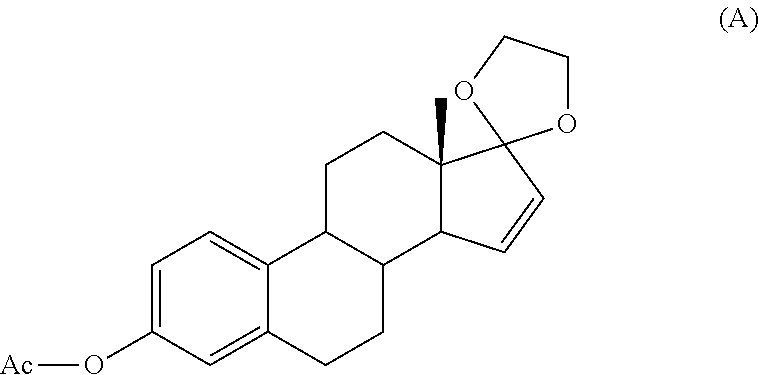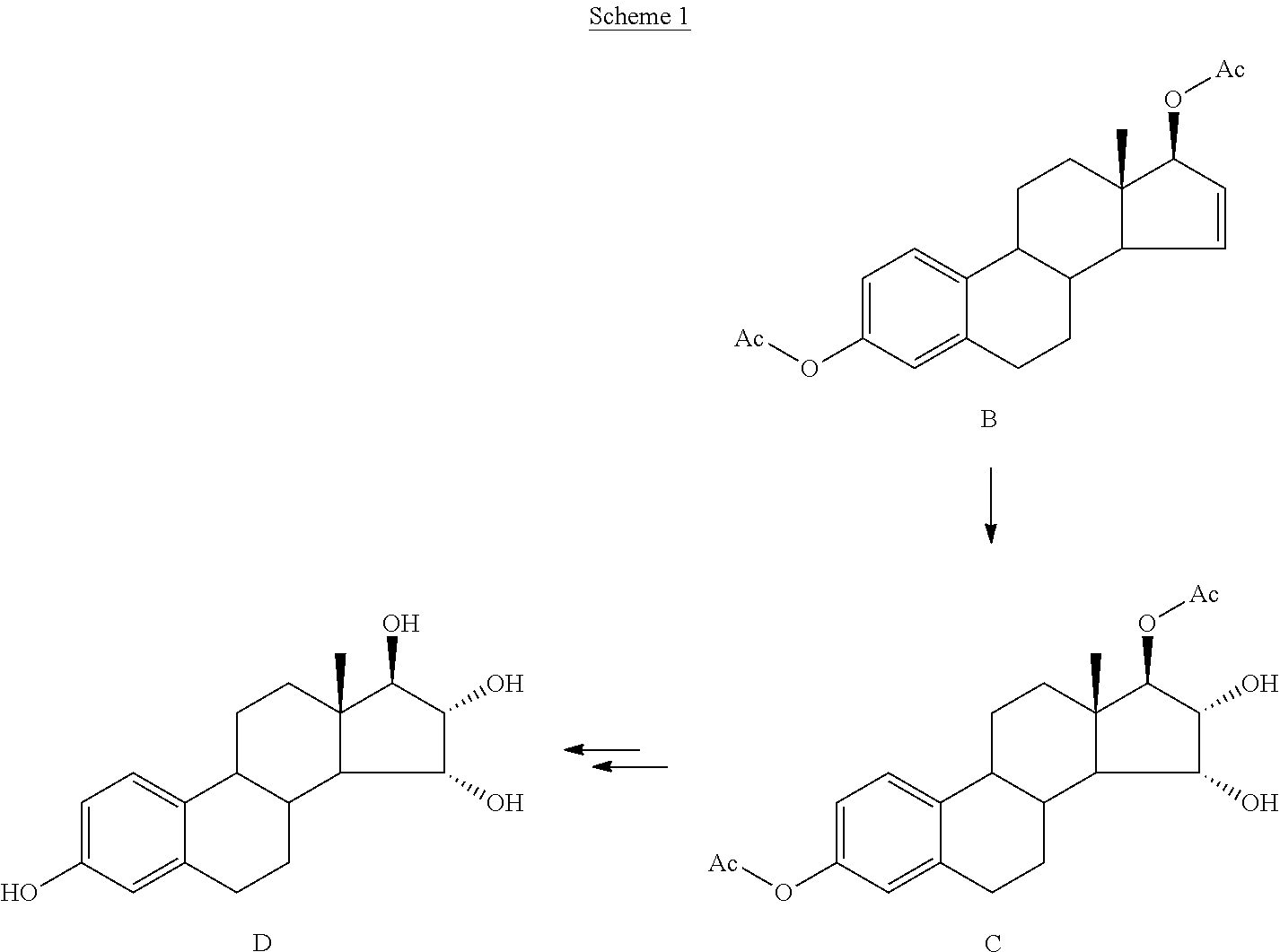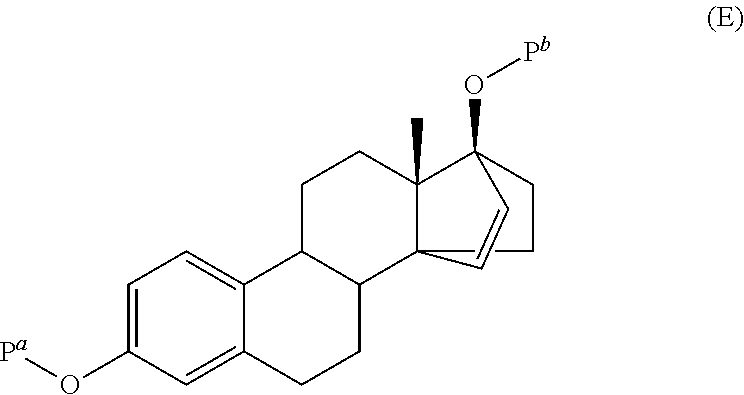Process for the Production of Estetrol
a technology of estetrol and sulfonate, which is applied in the field of estetrol synthesis and synthesis, can solve the problems of complete failure of the attempt to remove the dioxolane group, and achieve the effect of reducing cost and high yield
- Summary
- Abstract
- Description
- Claims
- Application Information
AI Technical Summary
Benefits of technology
Problems solved by technology
Method used
Image
Examples
example 1
Preparation of a Compound of Formula (I) Using tert-butyl-dimethyl-silyl Group as Protecting Group for P1 and P2 According to an Embodiment of the Invention
Step 1: estra-1,3,5(10),15-tetraene-3,17β-diol bis(dimethyl-tert-butylsilyl) ether
[0131]The starting material 3-t-butyldimethylsiloxy-estra-1,3,5 (10)-15-tetraene-17β-ol can be prepared as described in Example 3 and 4. To a solution of 3-t-butyldimethylsiloxy-estra-1,3,5 (10)-15-tetraene-17β-ol (10 g, 0.025 mole) in 100 ml of dimethylformamide were added imidazole (4.4 g, 0.065 mole) and dimethyl-tert-butylsilyl-chloride (1.5 eq.) and allowed to stand at room temperature for 6 hours. The resulting solution was diluted with ethyl acetate, washed with water and evaporated. The residue was crystallized from methanol to afford (10 g) of estra-1,3,5(10),15-tetraene-3,17β-diol bis(dimethyl-tert-butylsilyl) ether.
[0132]NMR (CDCl3): 0.08 (6H, s, 17-OSi(CH3)2, 0.18 (6H, 3-OSi(CH3)2, 0.81 (3H, s, 18-CH3), 0.91 (9H, 17-OSi-t-Bu), 0.97 (9H, ...
example 2
Preparation of a Compound of Formula (I) Using tert-butyl-dimethyl-silyl Group as Protecting Group for P1 and pivaloyl for P2 According to an Embodiment of the Invention
[0135]The starting material 3-t-butyldimethylsiloxy-estra-1,3,5 (10)-15-tetraene-17β-ol can be prepared as described in Example 3 and 4. To a solution of 3-tert-butyldimethylsilyloxy-estra-1,3,5(10)-15-tetraene-17-ol (30 g, 0.078 mole) in 300 ml of dichloromethane and 11 ml of triethylamine were added drop wise 10.36 g (0.086 mole) of pivaloyl chloride in 50 ml of methylene chloride at 0° C. At the end of the addition the solution was stirred at room temperature for 1 hour. Water was added and the organic layer was washed two time with 100 ml of water. Heptane was added and the product was collected by filtration and used in the next step without any other purification.
[0136]3-terbutyl-dimethylsilyloxy-estra-1,3,5(10)-15-tetraene-17β-pivaloate was converted to its 15α,16α derivative following the procedure described ...
example 3
Preparation of a Compound of Formula (II) Wherein P1 is t-butyldimethylsilyl According to an Embodiment of the Invention
Step 1: 3,17-di-t-butyldimethylsiloxy-estra-1,3,5(10)-16-tetraene-17-ol
[0139]To a solution of estrone (50 g, 0.185 mole) and 2,6-lutidine (62 g, 0.58 mole) in dichloromethane 400 ml was added drop wise t-butyl-dimethylsilyl-triflate (102.6 g, 0.39 mole). The solution was stirred at room temperature for 6 hours. Water (300 ml) was added and the organic layer was washed with a diluted solution of sodium carbonate. The dichloromethane solution was partially evaporated and ethyl acetate was added. Diisopropyl ether was added to this solution. The mixture was stirred for 2 hours at 0° C. The precipitate was collected by filtration and dried. 83 g of the title compound were obtained (90% yield).
Step 2: 3-t-butyldimethylsiloxy-estra-1,3,5(10)-15-tetraene-17-one
[0140]To a solution of 3,17-di-t-butyldimethylsiloxy-estra-1,3,5(10)-16-tetraene-17-ol 83 g (0.166 mole) in 400 m...
PUM
 Login to View More
Login to View More Abstract
Description
Claims
Application Information
 Login to View More
Login to View More - R&D
- Intellectual Property
- Life Sciences
- Materials
- Tech Scout
- Unparalleled Data Quality
- Higher Quality Content
- 60% Fewer Hallucinations
Browse by: Latest US Patents, China's latest patents, Technical Efficacy Thesaurus, Application Domain, Technology Topic, Popular Technical Reports.
© 2025 PatSnap. All rights reserved.Legal|Privacy policy|Modern Slavery Act Transparency Statement|Sitemap|About US| Contact US: help@patsnap.com



